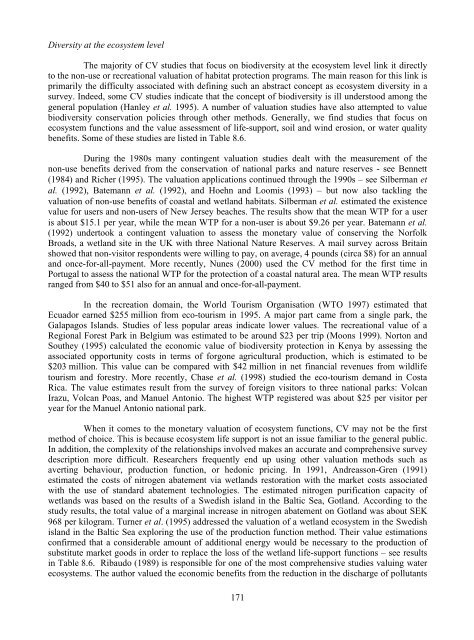Diversity at the ecosystem levelThe majority <strong>of</strong> CV studies that focus on biodiversity at the ecosystem level link it directlyto the non-use or recreational valuation <strong>of</strong> habitat protection programs. The main reason for this link isprimarily the difficulty associated with defining such an abstract concept as ecosystem diversity in asurvey. Indeed, some CV studies indicate that the concept <strong>of</strong> biodiversity is ill understood among thegeneral population (Hanley et al. 1995). A number <strong>of</strong> valuation studies have also attempted to valuebiodiversity conservation policies through other methods. Generally, we find studies that focus onecosystem functions and the value assessment <strong>of</strong> life-support, soil and wind erosion, or water qualitybenefits. Some <strong>of</strong> these studies are listed in Table 8.6.During the 1980s many contingent valuation studies dealt with the measurement <strong>of</strong> thenon-use benefits derived from the conservation <strong>of</strong> national parks and nature reserves - see Bennett(1984) and Richer (1995). The valuation applications continued through the 1990s – see Silberman etal. (1992), Batemann et al. (1992), and Hoehn and Loomis (1993) – but now also tackling thevaluation <strong>of</strong> non-use benefits <strong>of</strong> coastal and wetland habitats. Silberman et al. estimated the existencevalue for users and non-users <strong>of</strong> New Jersey beaches. The results show that the mean WTP for a useris about $15.1 per year, while the mean WTP for a non-user is about $9.26 per year. Batemann et al.(1992) undertook a contingent valuation to assess the monetary value <strong>of</strong> conserving the NorfolkBroads, a wetland site in the UK with three National Nature Reserves. A mail survey across Britainshowed that non-visitor respondents were willing to pay, on average, 4 pounds (circa $8) for an annualand once-for-all-payment. More recently, Nunes (2000) used the CV method for the first time inPortugal to assess the national WTP for the protection <strong>of</strong> a coastal natural area. The mean WTP resultsranged from $40 to $51 also for an annual and once-for-all-payment.In the recreation domain, the World Tourism Organisation (WTO 1997) estimated thatEcuador earned $255 million from eco-tourism in 1995. A major part came from a single park, theGalapagos Islands. Studies <strong>of</strong> less popular areas indicate lower values. The recreational value <strong>of</strong> aRegional Forest Park in Belgium was estimated to be around $23 per trip (Moons 1999). Norton andSouthey (1995) calculated the economic value <strong>of</strong> biodiversity protection in Kenya by assessing theassociated opportunity costs in terms <strong>of</strong> forgone agricultural production, which is estimated to be$203 million. This value can be compared with $42 million in net financial revenues from wildlifetourism and forestry. More recently, Chase et al. (1998) studied the eco-tourism demand in CostaRica. The value estimates result from the survey <strong>of</strong> foreign visitors to three national parks: VolcanIrazu, Volcan Poas, and Manuel Antonio. The highest WTP registered was about $25 per visitor peryear for the Manuel Antonio national park.When it comes to the monetary valuation <strong>of</strong> ecosystem functions, CV may not be the firstmethod <strong>of</strong> choice. This is because ecosystem life support is not an issue familiar to the general public.In addition, the complexity <strong>of</strong> the relationships involved makes an accurate and comprehensive surveydescription more difficult. Researchers frequently end up using other valuation methods such asaverting behaviour, production function, or hedonic pricing. In 1991, Andreasson-Gren (1991)estimated the costs <strong>of</strong> nitrogen abatement via wetlands restoration with the market costs associatedwith the use <strong>of</strong> standard abatement technologies. The estimated nitrogen purification capacity <strong>of</strong>wetlands was based on the results <strong>of</strong> a Swedish island in the Baltic Sea, Gotland. According to thestudy results, the total value <strong>of</strong> a marginal increase in nitrogen abatement on Gotland was about SEK968 per kilogram. Turner et al. (1995) addressed the valuation <strong>of</strong> a wetland ecosystem in the Swedishisland in the Baltic Sea exploring the use <strong>of</strong> the production function method. Their value estimationsconfirmed that a considerable amount <strong>of</strong> additional energy would be necessary to the production <strong>of</strong>substitute market goods in order to replace the loss <strong>of</strong> the wetland life-support functions – see resultsin Table 8.6. Ribaudo (1989) is responsible for one <strong>of</strong> the most comprehensive studies valuing waterecosystems. The author valued the economic benefits from the reduction in the discharge <strong>of</strong> pollutants171
in waterway systems for nine impact categories: recreational fishing, navigation, water storage,irrigation ditches, water treatment, industrial water use, steam cooling, and flooding. <strong>Benefits</strong> weredefined in terms <strong>of</strong> changes in defensive expenditures 66 , changes in production costs, or changes inconsumer surplus, depending on the damage category and the availability <strong>of</strong> data. The total waterquality benefits were estimated to be $4.4 billion.Integrated ecological-economic modelling and valuation <strong>of</strong> biodiversityEconomics – Ecology interfaceThe analysis and the modelling <strong>of</strong> biodiversity are rooted in both natural and social sciencesand thus imply the study <strong>of</strong> human economic activities, their relationship to biodiversity and thestructure and functions <strong>of</strong> ecosystems. The combination or integration <strong>of</strong> the two approaches implies asomewhat qualitative, formal, sequentially integrated framework. Interdisciplinary work involveseconomists or ecologists transferring elements or even theories and models from one discipline toanother and transforming them for their specific purpose (Perrings et al. 1995). The underlyingobjective <strong>of</strong> this approach is the development <strong>of</strong> a common way <strong>of</strong> thinking about modelling andvaluation <strong>of</strong> biodiversity. For instance, if economic and ecological models fit in a general systemframe, then they may be blended in a single model structure where compartments or modules mayrepresent the original models and certain outputs <strong>of</strong> one module serve as input for another.Nevertheless, it is not <strong>of</strong>ten easy to link models directly. Alternatively, if both the economic andecological systems are represented in the form <strong>of</strong> programming or optimisation models then severaloptions are available: look for a new, aggregate objective; adopt a multi-objective or conflict analysisframework; or, when possible, derive multiple sets <strong>of</strong> optimality conditions and solve thesesimultaneously. Finally, when economic and ecological systems are represented by different modeltypes, it is harder to suggest how they can be linked to one another. Where economic models have anoptimisation format and ecosystem models have a descriptive format, then a direct technicalintegration seems feasible, otherwise heuristic approaches are needed. This may require operationssuch as reduction, simplifying or summarising. For example, one can come up with a simple dynamicmodel summarising and simplifying some <strong>of</strong> the causal relationships <strong>of</strong> the spatial hydrological modeland the statistical vegetation model, and linking the outcomes to a simplified economic interaction andvalues model.Before discussing specific methods and models it is useful to briefly analyse the pros andcons <strong>of</strong> integration frameworks and respective conceptual perspectives. These are discussed in thefollowing section.Integrated modelling and assessmentA general method to develop integrated models is a systems approach (also ‘systemsdynamics’). This covers a wide range <strong>of</strong> model types: linear versus non-linear, continuous versusdiscrete, deterministic versus stochastic, and optimising versus descriptive. Such system approachesallow one to deal with concepts like ecological dynamic processes, feedback mechanisms, andcontrolling strategies (see Bennett and Chorley 1978; Costanza et al. 1993). One can integrate twosubsystems, or have a hierarchy or nesting <strong>of</strong> systems. The systems approach is suitable for integratingexisting models and incorporating temporal as well as spatial processes. Costanza et al. distinguisheconomic, ecological and integrated approaches on the basis <strong>of</strong> the following criteria: (1) generality,66These are expenditures incurred with the purchase <strong>of</strong> market goods with the goal to mitigate theexternality <strong>of</strong> flooding, e.g. river silp up activities.172
- Page 1 and 2:
«ENVIRONMENTValuation ofBiodiversi
- Page 3 and 4:
ORGANISATION FOR ECONOMIC CO-OPERAT
- Page 5 and 6:
TABLE OF CONTENTSPART 1 ...........
- Page 7 and 8:
PART 4 ............................
- Page 10 and 11:
Why value biodiversity?There are th
- Page 12 and 13:
Figure 1.1 Total economic value: us
- Page 14 and 15:
from biodiversity at the local leve
- Page 16 and 17:
in the database and also for undert
- Page 18 and 19:
in the policy context. This is high
- Page 20:
Table 1.3 Policy Options for the Cl
- Page 23 and 24:
Box 1.2 Value of Turkey’s Forests
- Page 25 and 26:
of the most important implications
- Page 27 and 28:
Additionally, valuation does not ju
- Page 29 and 30:
value is the habitat, many differen
- Page 31 and 32:
are very modest. More recently, new
- Page 33 and 34:
Table 2.2 Estimates of the Medicina
- Page 35 and 36:
The importance of indirect use valu
- Page 37 and 38:
pharmaceutical use, although the li
- Page 39 and 40:
McAllister, D., (1991). Estimating
- Page 41 and 42:
Simpson, D and Craft, A.. (1996).
- Page 43 and 44:
practice, the overlap between these
- Page 45 and 46:
aimed at giving more precise quanti
- Page 47 and 48:
structural values. There are a numb
- Page 49 and 50:
Reid (forthcoming) discusses the po
- Page 51 and 52:
Ecotourism as a Way to Generate Loc
- Page 53 and 54:
endangered Indian rhino and other t
- Page 55 and 56:
ReferencesBann, C., and M. Clemens
- Page 57 and 58:
PART 261
- Page 59 and 60:
many European countries, CBA has a
- Page 61 and 62:
(1) Cost and time constraintsThe co
- Page 63 and 64:
activity day, there is greater vari
- Page 65 and 66:
added independent variable C s= cha
- Page 67 and 68:
error in valuing respiratory sympto
- Page 69 and 70:
ReferencesArrow, K.J., R. Solow, E.
- Page 71 and 72:
OECD (1995). The Economic Appraisal
- Page 73 and 74:
CHAPTER 5:by José Manuel LIMA E SA
- Page 75 and 76:
linkages usually lead to diverse co
- Page 77 and 78:
A discrete choice approach to quest
- Page 79 and 80:
Table 5.2 Model-based point estimat
- Page 81 and 82:
is potentially very large for multi
- Page 83 and 84:
P3 is already in the mix is 2.51, s
- Page 85 and 86:
PART 391
- Page 87 and 88:
measures of value. An appendix to t
- Page 89 and 90:
features (such as parks, beaches or
- Page 91 and 92:
included in cost-benefit analysis o
- Page 93 and 94:
A Discussion of Past Efforts to Dev
- Page 95 and 96:
Satellite AccountsIn addition to th
- Page 97 and 98:
which many people argue are associa
- Page 99 and 100:
approach to competing uses of water
- Page 101 and 102:
Figure 6.2 Trade-Off AnalysisEnviro
- Page 103 and 104:
However, the farmers need not bear
- Page 105 and 106:
Appendix 1: Theory and Application
- Page 107 and 108:
iwhere C is the income adjustment n
- Page 109 and 110:
complete. If there are more than on
- Page 111 and 112: Horowitz, Joel. L. and Jordan. J. L
- Page 113 and 114: CHAPTER 7:by Dennis M. KING and Lis
- Page 115 and 116: Box 7.1 Definition of terms related
- Page 117 and 118: Box 7.2 Categories of Ecosystem Ser
- Page 119 and 120: Box 7.4 Dollar-based ecosystem valu
- Page 121 and 122: Non-monetary indicators of ecosyste
- Page 123 and 124: Figure 7.1 Effects of Wetland Locat
- Page 125 and 126: description, and that the usefulnes
- Page 127 and 128: 2) Service capacity sub-indexIndica
- Page 129 and 130: wetlands, for example, results in F
- Page 131 and 132: (1) Functional CapacityIndexFigure
- Page 133 and 134: constituents of runoff can be predi
- Page 135 and 136: Service(on or off site)Recreational
- Page 137 and 138: Table 7.3 Service Risk Sub-index De
- Page 139 and 140: Measuring Service Preference Weight
- Page 141 and 142: Table 7.4 Illustration of Paired Co
- Page 143 and 144: PART 4151
- Page 145 and 146: Ecological foundations for biodiver
- Page 147 and 148: Phenotic diversity is a measure bas
- Page 149 and 150: Operationalisation of the biotic-ri
- Page 151 and 152: ten attributes that could score a m
- Page 153 and 154: The choice of the scale relates to
- Page 155 and 156: Nature measurement methodIn 1995, t
- Page 157 and 158: Table 8.4 Value orientations and en
- Page 159 and 160: Table 8.5 Identification of monetar
- Page 161: Table 8.6 Valuation studiesSingle s
- Page 165 and 166: to other contexts, conditions, loca
- Page 167 and 168: ReferencesAkcakaya, H.R. (1994).
- Page 169 and 170: de Groot, R.S. (1994). “Environme
- Page 171 and 172: Mace, G. M. & S. N. Stuart. (1994).
- Page 173 and 174: Turner, R.K., Perrings, C. and Folk
- Page 175 and 176: John A. DixonJohn A. Dixon is Lead
- Page 177 and 178: Robert O’NeillDr. O’Neill recei
- Page 179 and 180: Steven StewartSteven Stewart is Ass
- Page 181: OECD PUBLICATIONS, 2, rue André-Pa












